Wound Healing Society Newsletter Volume 3 Issue 2
Wound Healing Society Newsletter Volume 3 Issue 2
Wound Healing Society Newsletter Volume 3 Issue 2
Create successful ePaper yourself
Turn your PDF publications into a flip-book with our unique Google optimized e-Paper software.
WHS <strong>Newsletter</strong><br />
The <strong>Wound</strong> <strong>Healing</strong> <strong>Society</strong> <strong>Volume</strong> 3 <strong>Issue</strong> 2<br />
Your WHS Board of Directors<br />
President<br />
2011-2012<br />
Harriet W. Hopf, MD<br />
President Elect<br />
2011-2012<br />
Robert F. Diegelmann, PhD<br />
Vice President<br />
2011-2012<br />
Paul Y. Liu, MD<br />
Secretary<br />
2010-2012<br />
Lisa Gould, MD<br />
Treasurer<br />
2006-2012<br />
Braham Shroot, PhD<br />
Past-President<br />
2010-2011<br />
Luisa Ann DiPietro, DDS, PhD<br />
Board Members<br />
Andrew Baird<br />
2010-2013<br />
Stéphanie Bernatchez,<br />
PhD, 2009-2012<br />
Nicole S. Gibran, MD,<br />
2009-2012<br />
Gayle Gordillo, MD,<br />
FACS, 2011-2014<br />
Robert Kirsner, MD,<br />
PhD, 2006-2012<br />
Kenneth Liechty, MD,<br />
2011-2014<br />
Representing <strong>Wound</strong> Repair<br />
and Regneration on the<br />
Board of Directors<br />
Laura K.S. Parnell, BS,<br />
MS, CWS, 2009-2012<br />
Joyce K. Stechmiller,<br />
PhD, ACNP-BC, FAAN,<br />
2010-2013<br />
James Tomasek, PhD,<br />
2011-2014<br />
Marjana Tomic-Canic,<br />
RN, PhD, 2011-2013<br />
Bios of each member of the board are available online at<br />
www.woundheal.org<br />
David Hart, PhD,<br />
2006-2012<br />
Patricia A. Hebda, PhD,<br />
2006-2015<br />
The <strong>Wound</strong> <strong>Healing</strong> <strong>Society</strong><br />
341 N. Maitland Avenue, Suite 130 Maitland, FL 32751 • Phone: 407-647-8839<br />
www.woundheal.org
The <strong>Wound</strong> <strong>Healing</strong> <strong>Society</strong> <strong>Newsletter</strong> <strong>Volume</strong> 3 <strong>Issue</strong> 2<br />
Table of Contents<br />
Presidents Message 2<br />
From the Editor 3<br />
Meeting Calendar 3<br />
WHS Profile: Jeffrey Davidson 4<br />
Contemporary Topics 6<br />
Pre-clinical Models of <strong>Wound</strong><br />
<strong>Healing</strong><br />
You Might Want to Know 8<br />
The History and Success of the<br />
3M Fellowship Award<br />
Blast From the Past 9<br />
Amsterdam, 1993<br />
WHS Committee Reports 10<br />
The 2011 WHS Annual<br />
Meeting in Pictures 12<br />
Sponsors 16<br />
The <strong>Wound</strong> <strong>Healing</strong> <strong>Society</strong><br />
Mission<br />
Improve wound healing<br />
outcomes through<br />
science, professional<br />
education, and<br />
communication by:<br />
• Leading multidisciplinary<br />
research in<br />
wound science<br />
and outcomes.<br />
• Linking scientists and<br />
clinicians to advance<br />
wound healing<br />
research.<br />
• Translating discovery<br />
into evidence based<br />
clinical outcomes.<br />
• Communicating<br />
through mentoring,<br />
education,<br />
publications, and<br />
global networking.<br />
<strong>Wound</strong> <strong>Healing</strong> <strong>Society</strong><br />
President’s Message<br />
By Harriet W. Hopf<br />
Dear WHS Members and Colleagues,<br />
The Annual Meeting, held jointly with the<br />
Symposium on Advanced <strong>Wound</strong> Care (SAWC)<br />
in Dallas April 14-17 was a great success, with<br />
outstanding scientific sessions and plenty of<br />
opportunities for networking and catching up with<br />
old friends and making new ones. You can find a<br />
review of highlights on throughout the newsletter.<br />
Before I talk about my goals and plans for the coming year, I want to<br />
thank Luisa DiPietro, DDS, PhD, for her outstanding stewardship over<br />
the past year. One major accomplishment was the review and revision<br />
of our Mission Statement along with a set of Guiding Principles. The<br />
new principles (see column at left) align with our societal goals and<br />
provide a reference point for decisions. This will help our Committees<br />
identify their most important goals and make most efficient use of our<br />
hard-working volunteers.<br />
Another of Luisa’s accomplishments came out of a collaboration<br />
between the Membership and Website Committees and Crow-Segal, our<br />
management company, to create an effective way of assigning members<br />
to committees. If you are interested in joining a committee, log in to the<br />
Members Only section of our web site (www.woundheal.org) and select<br />
the “Click here to join a committee!” button.<br />
Other accomplishments of note:<br />
• Congratulations and welcome to our new Vice President, Paul Liu,<br />
and new members of the Board of Directors, Gayle Gordillo, Kenneth<br />
Liechty, James Tomasek, and Marjana Tomic-Canic.<br />
• Thanks to retiring BOD members Paul Liu, Chandan Sen, Oluyinka<br />
Olutoye, and Laura Bolton. But don’t think you are done with service to<br />
the WHS yet!<br />
• Congratulations to Pat Hebda, PhD, recipient of the 2011 Distinguished<br />
Service Award. Pat’s contributions as Editor-in-Chief of our journal,<br />
<strong>Wound</strong> Repair and Regeneration, and President have been enormous.<br />
• Thanks to Annette Wysocki for bringing the <strong>Wound</strong> <strong>Healing</strong> <strong>Society</strong><br />
Foundation into compliance with the non-profit rules and regulations<br />
so that we can move forward with fund-raising to help promote the<br />
mission of our society.<br />
In the coming year, I have five major objectives:<br />
1. Work with our committee chairs to confirm that their ongoing work<br />
and new initiatives align with our Mission and Guiding Principles and<br />
invest resources in increasing their productivity.<br />
2. Revitalize less active committees by identifying long-term goals and<br />
short-term projects that align with our Mission and Guiding Principles.<br />
3. Complete the process of getting our Acute and Chronic <strong>Wound</strong><br />
Prevention and Treatment Guidelines listed on guidelines.gov and<br />
initiate the process of revising the guidelines for publication.<br />
4. Work with the <strong>Wound</strong> <strong>Healing</strong> Foundation to create a business plan for<br />
growing their fund-raising program.<br />
continued next page<br />
2 www.woundheal.org
The <strong>Wound</strong> <strong>Healing</strong> <strong>Society</strong> <strong>Newsletter</strong> <strong>Volume</strong> 3 <strong>Issue</strong> 2<br />
5. The WHS Board of Directors will hold a<br />
facilitated Strategic Planning Meeting<br />
in November to assess how to keep our<br />
annual meeting aligned with our Mission<br />
and Guiding Principles. This is particularly<br />
important to inform the negotiations as we<br />
approach the end of our current contract<br />
with HMP/NACCME (2013).<br />
I am grateful for the many contributions of<br />
our hard working members. I look forward to<br />
working with you and for you in the coming<br />
year. Please feel free to contact me with your<br />
ideas and questions: president@woundheal.<br />
org.<br />
With Warm Regards,<br />
Harriet<br />
The <strong>Wound</strong> <strong>Healing</strong> <strong>Society</strong><br />
From the Editor<br />
By Manuela Martins-Green,<br />
University of California-Riverside<br />
Do you have too much on your plate?<br />
Are you overwhelmed because of<br />
increased obligations at home and<br />
at work? If you feel this way, you are<br />
not alone. Times are trying! Imagine<br />
yourself going through a self-service<br />
bar. You are hungry and can’t resist<br />
taking some of everything. Very soon,<br />
without realizing it, your plate is not<br />
only full, but overflowing. This might<br />
just be comparable to your feeling overwhelmed.<br />
The right thing to do would be to take the plate to<br />
your table, take a careful look at what is in it, and<br />
begin to eliminate those portions of food that are the<br />
least healthy for you, then those with the most empty<br />
calories, and finally those that you put on the plate but<br />
you might not be particularly fond of. Now your plate<br />
is no longer overflowing but contains healthy food and<br />
you can enjoy your meal.<br />
In life, there are occasions when you say “yes” too<br />
many times and, without realizing it, your plate of<br />
commitments is overflowing. Take a look at them and<br />
eliminate those that do not allow you to enjoy your<br />
private and professional life. Then organize what<br />
is left and take the time to carry out your chosen<br />
commitments to a successful fruition.<br />
National & International Meetings<br />
Please send any comments or suggestions about the<br />
newsletter to me directly at manuela.martins@ucr.edu<br />
September 1-4, 2011<br />
5th International Conference on “Oxidative<br />
Stress in Skin Biology and Medicine”<br />
Andros Island, Greece<br />
Information: www.pharm.uoa.gr/oxstress<br />
October 5-7. 2011<br />
European Tissue Repair <strong>Society</strong> Congress<br />
Felix Meritis Complex<br />
Amsterdam, The Netherlands<br />
Information: www.etrs2011.org<br />
October 27-29, 2011<br />
First International Pediatric <strong>Wound</strong> Care<br />
Symposium<br />
Rome, Italy<br />
Information: www.ispew.eu, Elena<br />
Baccalaro +39 011 244 69 11.<br />
December 3-7, 2011<br />
American <strong>Society</strong> for Cell Biology Annual<br />
Meeting<br />
Denver, CO<br />
Information: www.ascb.org<br />
December 5-6, 2011<br />
Japanese <strong>Society</strong> for <strong>Wound</strong> <strong>Healing</strong><br />
Congress<br />
WINC AICHI, Nagoya, Aichi, Japan<br />
Information: jswh41yyfujita-hu.ac.jp<br />
March 18-22, 2012<br />
Australian <strong>Wound</strong> Management<br />
Association Conference<br />
Sydney Convention & Exhibit Center<br />
Sydney, Australia<br />
Information: www.awma2012.com<br />
April 19-22, 2012<br />
SAWC & WHS 2012 Annual Meeting<br />
Georgia World Congress, Atlanta, GA<br />
Information: www.woundheal.org<br />
The <strong>Wound</strong> <strong>Healing</strong> <strong>Society</strong><br />
<strong>Wound</strong> <strong>Healing</strong> <strong>Society</strong><br />
3 www.woundheal.org
The <strong>Wound</strong> <strong>Healing</strong> <strong>Society</strong> <strong>Newsletter</strong> <strong>Volume</strong> 3 <strong>Issue</strong> 2<br />
WHS Profile<br />
Jeffrey Davidson<br />
By Sabine Eming, Susan Opalenik and Lillian Nanney<br />
The European Connection<br />
(by Sabine Eming)<br />
I first met Jeff at the Gordon Research Conference<br />
on <strong>Wound</strong> Repair in 1995, when he was introduced<br />
to me by Thomas Krieg. At that time I was a post-doc<br />
and not yet completely decided how to develop my<br />
career. However, I guess the “Gordon encounter”<br />
engraved a wonderful destination for my future life.<br />
Jeff inspired me to investigate a novel gene transfer<br />
technique at that time. He generously invited me to<br />
visit Vanderbilt to examine the technology. So, I spent<br />
several very fruitful weeks in his laboratory, learned<br />
a lot, met his wonderful Italian wife Gabriella and<br />
son Nicolo, and had a memorable time in Nashville.<br />
Thereafter, I brought the knowledge back home to<br />
the department of Thomas Krieg in Cologne and to<br />
this day we continue to collaborate on a number<br />
of projects. I am proud to say that, over the years,<br />
Jeff became a friend and mentor and I am thankful<br />
for his continuous helpful advice. Not only did Jeff<br />
affect my personal professional development, but<br />
he has been quite helpful in my current position as<br />
ETRS president. I would like to express my sincere<br />
appreciation for his disposition to discuss and<br />
provide advice, particularly on how to strengthen<br />
the interrelation between ETRS and WHS. Like many<br />
other WHS friends, Jeff significantly contributes to<br />
the hearty, pleasant and constructive atmosphere<br />
when “ETRS meets WHS.” Therefore, also in the<br />
name of my ETRS colleagues, we would like to<br />
thank Jeff for his wonderful support, guidance, and<br />
leadership.<br />
The Laboratory Connection<br />
(by Susan Opalenik)<br />
I first met Jeff in 1999, when I was searching for a new<br />
post-doc position at Vanderbilt. I can still remember<br />
our first meeting. In his 100 sq ft, federal-issue<br />
office, with about 20 sq ft of available floor space,<br />
we chatted. In the words of Harold S. Geneen, “If<br />
your desk isn’t cluttered, you probably aren’t doing<br />
your job.” Trust me, and anyone who has seen Jeff’s<br />
office, there is no doubt that Jeff is always doing his<br />
job.<br />
I asked what would be any negatives with regards to<br />
joining his laboratory. He replied, “I’m out of town<br />
a lot,” and to that I said, “Well, I guess that’s all a<br />
matter of perspective.” The rest is history. He wasn’t<br />
kidding; Jeff travels the globe consulting, going to<br />
conferences and meeting with collaborators, as well<br />
as significant pleasure travel abroad with his family.<br />
All too often I’m asked, “Is Dr. D in town?”<br />
When Jeff is in Nashville, he is an avid cyclist;<br />
weather permitting, he bikes the 6+ miles to campus<br />
most days, and maintains a very active and healthy<br />
lifestyle. He will probably outlive most of us – though<br />
the occasional “honey bun” won’t hurt, right? He<br />
and his wife Gabriella also share a passion for the<br />
arts and frequent the symphony, opera, ballet, and<br />
numerous Broadway shows. He is also the proud<br />
father of a newly barred patent attorney; so, if in<br />
need, give Nicolo a call.<br />
Jeffrey Davidson<br />
When students ask me my opinion of Jeff, I tell<br />
them that he is a thinker, rigorous but fair. He does<br />
not question the obvious, but goes beyond what is<br />
presented, so be prepared. If anyone has been at a<br />
seminar or meeting with Jeff, you know that he will<br />
ask one of the more insightful questions posed to the<br />
speaker, even though he will most likely be multitasking<br />
– reviewing a manuscript or grant, working<br />
on his computer (a Mac of course), checking his<br />
continued next page<br />
<strong>Wound</strong> <strong>Healing</strong> <strong>Society</strong><br />
4 www.woundheal.org
The <strong>Wound</strong> <strong>Healing</strong> <strong>Society</strong> <strong>Newsletter</strong> <strong>Volume</strong> 3 <strong>Issue</strong> 2<br />
smart phone, or examining the inside of his eyelids<br />
– if you know what I mean (jet lag).<br />
He has been instrumental in my personal career<br />
development as well as that of countless others, with<br />
whom he is generous with his time and resources.<br />
He is responsible for introducing me to the WHS and<br />
all the benefits of membership and involvement.<br />
I am grateful that this portion of my life’s journey<br />
was under his guidance and with his laboratory. In<br />
cycling terms, the “yellow jersey” certainly awaits<br />
those who share a “stage” with Jeff.<br />
The Contemporary Connection<br />
(by Lillian Nanney)<br />
About 28 years ago, I was a new faculty member at<br />
Vanderbilt. While doing a literature search for one<br />
of my first wound healing papers, I accidentally<br />
discovered a wonderful paper. When I realized<br />
that its author, Jeff Davidson, was based out of<br />
Vanderbilt’s Pathology department, I hustled over<br />
to his notorious VA office. Thus began a friendship<br />
and professional collaboration that has continued<br />
throughout the years.<br />
Jeff’s cool demeanor makes it all the more unexpected<br />
when he displays his sense of humor and adds<br />
some of the most succinct and clever comments to<br />
lighten the mood in response to some bureaucratic<br />
nonsense. Back in the early days at Vanderbilt, Jeff<br />
would apply the biochemical approach and I would<br />
supply the morphology aspect. The papers began to<br />
flow. I soon learned that Jeff was absolutely gifted<br />
when it came to manuscript revision. Nationally, his<br />
abilities in this realm are no longer a secret, and he<br />
is frequently tapped to serve as an associate editor.<br />
Watch out – if you get in his sights he will swiftly<br />
bestow on you the honor and privilege of reviewing<br />
a basic science paper in the WRR.<br />
Jeff has been a national meeting organizer more<br />
times than I can recall. He has secret cards to play –<br />
he has friends and collaborators all over the world.<br />
To pull a meeting together, he merely asks his<br />
considerable cadre of friends and colleagues from<br />
universities or from industry to come engage in a<br />
little fun and intellectual exchange. Before you know<br />
it, a stellar conference has been assembled.<br />
A personal commentary about Jeff would not be<br />
complete without saying that he has been a tireless<br />
champion and workhorse within the <strong>Wound</strong> <strong>Healing</strong><br />
<strong>Society</strong>. I rather view him as a self-appointed<br />
international ambassador and advocate for wound<br />
healing science. He has served on innumerable<br />
committees, the WHS Board of Directors, and was<br />
co-chair of the program committee for the 2004,<br />
14th Annual Meeting in Atlanta. He diligently worked<br />
himself up through the WHS leadership chain to<br />
become our President in 2005.<br />
Well, that has been a while ago, so you are probably<br />
curious to know what Jeff is doing at this very<br />
moment. As I write this brief glimpse, he is wrapping<br />
up a week at the aforementioned Gordon Research<br />
Conference. That’s what Jeff always does every<br />
other year in June. After all, Jeff was the organizer<br />
of the very first GRC on “<strong>Wound</strong> Repair” in 1993,<br />
which has since been renamed “Tissue Repair &<br />
Regeneration.”<br />
In short, Jeff is perpetually on the go. His life<br />
reminds me of children’s book series “Where in<br />
the World is Waldo.” In the next week I would be<br />
willing to place bets that Jeff will be traveling to a<br />
meeting to chat and exchange insightful ideas with<br />
friends, reviewing another NIH grant, planning and<br />
interpreting innovative new research directions with<br />
a multi-faceted team at Vanderbilt, or maybe off<br />
biking in Italy.<br />
Abstract submissions will open September 26<br />
and must be submitted online by the<br />
deadline of December 12, 2011.<br />
<strong>Wound</strong> <strong>Healing</strong> <strong>Society</strong><br />
5 www.woundheal.org
The <strong>Wound</strong> <strong>Healing</strong> <strong>Society</strong> <strong>Newsletter</strong> <strong>Volume</strong> 3 <strong>Issue</strong> 2<br />
Contemporary Topics<br />
Pre-Clinical Models of Would <strong>Healing</strong><br />
By Jeffrey Davidson, Andrew Baird,<br />
and Marjana Tomic-Canic<br />
The 2011 WHS Annual meeting in Dallas, Texas was<br />
jumpstarted by a half-day pre-conference workshop<br />
called “Pre-Clinical Models of <strong>Wound</strong> <strong>Healing</strong>.” The<br />
Organizing Program Committee sponsored this<br />
special session of our annual meeting to stimulate<br />
a dialogue between investigators and promote<br />
discussions on the advantages and disadvantages of<br />
different animal and human models to study wound<br />
healing.<br />
Because of their broad relevance to many WHS<br />
members, the emphasis of this first meeting was<br />
specifically designed to address the different needs<br />
faced by the WHS’s diverse membership in basic,<br />
clinical, and translational research. The Program<br />
Committee hoped that if there was sufficient interest,<br />
then the topic could be refined as an ongoing<br />
discussion amongst its membership and brought up<br />
again at subsequent WHS meetings.<br />
Judging by the levels of interest and the ultimate<br />
attendance, this topic is of high importance to WHS<br />
members and the workshop was remarkable in several<br />
ways. The attendance exceeded expectations, with<br />
more than 70 enthusiastic participants filling the venue<br />
to capacity (registration was required, but was free of<br />
charge).<br />
To the surprise of the organizers, the great majority<br />
of the attendees were from industry rather than<br />
academia. While not intended to be an actual<br />
consensus conference, the workshop certainly<br />
pointed to a need to discuss the suitability of<br />
preclinical models for wound healing drug and device<br />
development.<br />
Andrew Baird provided a short introduction to the<br />
workshop by stating its goals: to present an overview<br />
of meaningful preclinical wound healing models<br />
and examine how each plays, or does not play, into<br />
the development of a clinical concept. Not all preclinical<br />
studies are required by the FDA and other<br />
agencies to permit assessments in human trials, but<br />
all of us should be concerned nevertheless about<br />
issues such as quality control and quality assurance<br />
of the materials we test, the validation of standard<br />
operating procedures that we use, and the need for<br />
reproducibility when reporting data.<br />
<strong>Wound</strong> <strong>Healing</strong> <strong>Society</strong><br />
Intense discussion by participants at Pre-Clinical<br />
Conference on Clinical Models<br />
Dr. Baird then outlined the overall strategy for the<br />
session, in which didactic presentations describing<br />
the use of animal models from the laboratory to the<br />
clinic would lead into a 90-minute breakout panel<br />
sessions for attendees to begin building a response to<br />
challenging questions.<br />
Jeff Davidson made the initial presentation called<br />
“Animal <strong>Wound</strong> <strong>Healing</strong> Models for Preclinical<br />
Development,” in which he discussed the advantages<br />
and disadvantages of wound models in typical<br />
laboratory mammalian species like mouse, rat,<br />
rabbit, and pig. Dr. Davidson emphasized the distinct<br />
requirements of basic research, investigational<br />
experimentation, and applied/translational studies.<br />
The examples were largely focused on surgical<br />
approaches, but many could be extended to burns or<br />
infection models.<br />
The presentation emphasized the importance of<br />
ensuring reproducibility and quantitative assessment.<br />
It addressed the range of wound types with a specific<br />
consideration of the various formats that can be<br />
utilized and the end points that could be evaluated.<br />
For example, the lecture emphasized the problems<br />
in interpreting wound closure in rodent models as a<br />
reflection of clinical outcomes in man. Rapid wound<br />
contraction is a poor representation of the typical<br />
filling of granulating wounds that occurs in both<br />
human and pig.<br />
An important aspect of the discussion that followed<br />
included the limitations inherent in highly controlled<br />
studies that use inbred animal strains to help<br />
predict clinical responses in a genetically and<br />
environmentally heterogeneous human population.<br />
continued next page<br />
6 www.woundheal.org
The <strong>Wound</strong> <strong>Healing</strong> <strong>Society</strong> <strong>Newsletter</strong> <strong>Volume</strong> 3 <strong>Issue</strong> 2<br />
For example, many of the diabetic models induce<br />
profound hyperglycemia in younger animals than<br />
what is experienced in human type II diabetes.<br />
Moreover, nearly all animal studies are carried out in<br />
juvenile animals, which hardly represent the biology<br />
of most patients with chronic wounds.<br />
Gabriel Sosne of Wayne State University used his<br />
presentation on “Thymosin beta 4: From Bench<br />
to Bedside” to move the discussion on preclinical<br />
models away from the laboratory and towards<br />
the unique hurdles in translational wound healing<br />
medicine. He described the development of thymosin<br />
b4 as an ophthalmologic treatment for a number of<br />
conditions. This peptide is currently in several clinical<br />
trials for repair of many tissues under a program<br />
sponsored by Regenerx.<br />
Dr. Sosne showed how the pre-clinical and clinical<br />
trial findings in rat corneal burn and epithelial injury<br />
and in vitro based assays were used to establish<br />
both the efficacy and safety of treatment. These<br />
findings resulted in FDA approval for compassionate<br />
use in epidermolysis bullosa and later diabetic and<br />
neurotrophic corneal ulcers. Dr. Sosne reported on<br />
current phase II clinical trials for dry eye syndrome,<br />
and then described the details of the process that is<br />
required to move a data information package of safety<br />
data, pharmacokinetic data, preclinical observations,<br />
and clinical compassionate need through FDA<br />
approval.<br />
The third presentation was a comprehensive<br />
discourse on the regulatory process by Michael<br />
Sabolinski on “Pre-Clinical and Clinical Trial<br />
Design for Regulatory Approval.” As former CEO<br />
of Organogenesis and a regulatory consultant<br />
(Aalnex), Dr. Sabolinski stressed that, from the FDA<br />
perspective, the primary value of preclinical studies<br />
is in the development of a safety portfolio, echoing<br />
the sentiment that animal models are an imperfect<br />
prelude to the critical stage of clinical trials. The<br />
scientific evidence of efficacy in animal models<br />
takes a lesser role than issues such as toxicity,<br />
pharmacokinetics, carcinogenesis, and teratogenicity<br />
in the case of pharmacologic approaches.<br />
Device development follows a different regulatory<br />
pathway that generally requires different preclinical<br />
testing, since the objective is to demonstrate<br />
equivalent performance rather than superiority arising<br />
from a physical rather than biochemical interaction<br />
with host tissue. The presentation included a detailed<br />
flow chart of the regulatory process and a step-by-step<br />
presentation of the various regulatory hurdles and<br />
obstacles to approval. Dr Sabolinski concluded his<br />
segment with an illustration of exemplary preclinical<br />
data that were used to obtain approval for Apligraf.<br />
This excellent overview led to a wide-ranging, thought<br />
provoking brainstorming discussion. Seven panels of<br />
participants were each charged with assessing one<br />
of the following topics: preclinical models of scar<br />
formation, infection, ischemia, diabetes, replacement/<br />
regeneration, metabolic models, and human models.<br />
For each topic, they were asked to review the most<br />
common approaches being used, their advantages and<br />
their disadvantages.<br />
When pressed to recommend the “ideal” model,<br />
the consensus of each panel was predictably the<br />
same: there is no perfect model. Instead, participants<br />
argued for the deployment of a combination of the<br />
complementary models as the key to performing<br />
accurate, reproducible, and scientifically sound<br />
science. The specific choice of animal models<br />
depends on the ultimate goal(s): basic science seeks<br />
to understand mechanisms, IND-enabling studies<br />
seek to explore efficacy, and IND models must test<br />
translational suitability.<br />
Although different panels identified different<br />
weaknesses of different models, there were a number<br />
of common themes that emerged from the group<br />
discussions while the panels presented their findings.<br />
For example, there was concern that pre-clinical models<br />
have a tendency to become somewhat contrived for<br />
both scientific and economic reasons. As scientists,<br />
we always seek to refine, reduce, and replace, while<br />
always maintaining the scientific integrity of our work.<br />
But does the genetic, epigenetic, nutritional, and<br />
environmental homogeneity of our animal models help,<br />
or harm, the application of data to the real world?<br />
In addition, there was discussion of the need for<br />
investigators to begin (in the laboratory) with the<br />
end in mind (in the clinic) when choosing different<br />
models. Finally, the specter of the economic reality<br />
of preclinical work was discussed. Whereas some<br />
models might be more predictive of outcome, the<br />
prohibitive cost precludes their deployment for most<br />
investigators.<br />
The WHS is very much interested in employing<br />
its members to participate in an ongoing<br />
discussion of this topic with a goal of formulating<br />
recommendations for specific pre-clinical models. To<br />
this end we plan to develop a web-based forum that<br />
will capture the ongoing dialogue and formulate a<br />
follow-up conference at WHS 2012. So, stay tuned!<br />
<strong>Wound</strong> <strong>Healing</strong> <strong>Society</strong><br />
7 www.woundheal.org
The <strong>Wound</strong> <strong>Healing</strong> <strong>Society</strong> <strong>Newsletter</strong> <strong>Volume</strong> 3 <strong>Issue</strong> 2<br />
You Might Want to Know<br />
The History and Success of the 3M Fellowship Award<br />
By Dr. Annette Wysocki, President of the <strong>Wound</strong> <strong>Healing</strong> <strong>Society</strong> Foundation<br />
The <strong>Wound</strong> <strong>Healing</strong> <strong>Society</strong> Foundation takes great<br />
pride in being able to award the 3M Fellowship<br />
each year to junior faculty or postdoctoral<br />
researchers. The <strong>Wound</strong> <strong>Healing</strong> <strong>Society</strong> Foundation<br />
awarded the first 3M Fellowship in 2000. This<br />
award was initiated almost immediately after the<br />
Foundation was started in 1999 by a dedicated<br />
group of leaders from the <strong>Wound</strong> <strong>Healing</strong> <strong>Society</strong>.<br />
Dr. Warren Rottman from 3M Healthcare, who was<br />
a founding member of the first Board of Directors<br />
of the <strong>Wound</strong> <strong>Healing</strong> <strong>Society</strong> Foundation, was<br />
instrumental in working with the Foundation to<br />
form a strategic corporate partnership to establish<br />
this award.<br />
Through the unwavering support of 3M Healthcare,<br />
the Fellowship Award had now been given for more<br />
than a decade to support the pioneering work of 12<br />
investigators. The areas of investigation have been<br />
diverse and represent both basic laboratory science<br />
as well as clinical investigation, with topics such<br />
as: “Stem Cells in <strong>Wound</strong> <strong>Healing</strong>,” by Dr. Susan<br />
Opalenik; “Antimicrobial Peptides as Effectors of<br />
<strong>Wound</strong> Repair,” by Dr. Vasumati Pestonjamasp;<br />
“Acupuncture and Surgical Site Complications<br />
in Patients Undergoing Coronary Artery Bypass<br />
Grafting,” by Dr. Jodi Sherman; and “Molecular<br />
Mechanisms of ß-Adrenergic Receptor Blockade<br />
that Attenuate Hypertrophic Scarring,” by Dr.<br />
Celeste Finnerty.<br />
Individuals who receive the 3M Fellowship<br />
Award present findings from their research at the<br />
annual 3M Lecture and Fellowship Award session,<br />
sponsored by the Foundation at the annual meeting<br />
of the <strong>Wound</strong> <strong>Healing</strong> <strong>Society</strong>. The 3M Fellow Award<br />
provides each investigator with $15,000 to support<br />
their program of research in their laboratory or<br />
in the laboratory of their mentor, if they are at<br />
the postdoctoral stage of their career. To date, the<br />
Foundation has awarded over $165,000 for this<br />
award.<br />
The purpose of the award is to stimulate scientific<br />
research and the career development of young<br />
investigators or junior faculty who are pursuing<br />
an academic career in wound healing research.<br />
The award is used for salary support or for direct<br />
costs associated with their program of research.<br />
Individuals who have received the award can take<br />
pride in knowing that they have been singled out<br />
for the award from an extremely high-quality pool<br />
of applicants.<br />
Many of the individuals who have received this<br />
award have become research faculty at various<br />
universities, and continue to be productive research<br />
scientists who have successfully competed for<br />
research funding from the National Institutes of<br />
Health or other private research organizations.<br />
Other individuals have continued to develop<br />
as successful clinicians and clinical research<br />
investigators. The 3M Fellow Award represents<br />
a major investment in the careers of promising<br />
investigators at the formative stages of their career<br />
by the <strong>Wound</strong> <strong>Healing</strong> <strong>Society</strong> Foundation.<br />
Sundeep Keswani accepting the 3M Award.<br />
One of the major goals of the Foundation is to<br />
increase the number of these awards because<br />
the number of individuals who compete for the<br />
award has increased since it was first awarded. The<br />
Foundation continues to look for other strategic<br />
partners, either individuals or companies, who<br />
are interested in sponsoring additional fellowship<br />
awards.<br />
Please contact Dr. Annette Wysocki, President<br />
of the <strong>Wound</strong> <strong>Healing</strong> <strong>Society</strong> Foundation for<br />
information if you would like to sponsor an<br />
additional fellowship or other award to support the<br />
research or educational mission of the Foundation.<br />
She can be contacted by calling 601-815-4267 or by<br />
e-mail at awysocki@umc.edu.<br />
<strong>Wound</strong> <strong>Healing</strong> <strong>Society</strong><br />
8 www.woundheal.org
The <strong>Wound</strong> <strong>Healing</strong> <strong>Society</strong> <strong>Newsletter</strong> <strong>Volume</strong> 3 <strong>Issue</strong> 2<br />
Blast from the Past<br />
By Harriet W. Hopf and Bob Diegelmann<br />
The 1993 WHS-ETRS joint annual meeting in<br />
Amsterdam was a wonderful gathering of scientists<br />
and clinicians from around the world. We thought<br />
it would be fun to revisit it in this newsletter in the<br />
run-up to the next Joint ETRS-WHS Meeting (and<br />
SAWC) April 19-23, 2012 in Atlanta, GA.<br />
Wiete Westerhof was President of the ETRS and<br />
Chair of the Organizing Committee. In his welcome<br />
address, he noted a record number of 253 abstracts<br />
submitted from all over Europe, the United States,<br />
and Asia. Paul Ehrlich was President of the WHS,<br />
and Kel Cohen was the incoming President.<br />
Blast from the past<br />
Drs. Westerhof and Cohen enjoying themselves<br />
at the conference.<br />
A number of familiar WHS faces presented,<br />
moderated, and networked at the meeting: Paul<br />
Ehrlich, Tom Hunt, Marty Robson, Diane Cooper,<br />
Pat Mertz, Jeff Davidson, Ted Tredget, Kel Cohen,<br />
Pat Hebda, Tom Mustoe, Harriet Hopf, Greg Schultz,<br />
and Bob Diegelmann. Hot topics included extracellular<br />
matrix, estrogen, infection, debridement,<br />
growth factors, tissue substitutes and dermal<br />
equivalents, negative pressure, diabetes, collagen,<br />
hyaluranic acid, wound measurement, transfusion<br />
and anemia, intestinal healing, matrix metalloproteinases,<br />
new dressings, and fetal wound<br />
healing.<br />
Attendees were housed mostly in quaint and<br />
beautiful hotels in downtown Amsterdam. Finding<br />
the RAI Congress Centre, a big, modern, functional<br />
building near the edge of town, was something<br />
of an adventure, but well worth the bus ride. The<br />
opening reception at the Municipal Museum was<br />
elegant and the closing party at the Grand Hotel<br />
Krasnopolsky was a high-energy affair where the<br />
leadership of both societies were found dancing<br />
with the best of them. In between, there was an<br />
abundance of science, networking, sightseeing,<br />
carousing, and fantastic food.<br />
Now it’s our turn to make the Atlanta meeting as<br />
welcoming and enjoyable for ETRS members as the<br />
Amsterdam meeting was for WHS members. Hope<br />
to see you there!<br />
<strong>Wound</strong> <strong>Healing</strong> <strong>Society</strong><br />
9 www.woundheal.org
The <strong>Wound</strong> <strong>Healing</strong> <strong>Society</strong> <strong>Newsletter</strong> <strong>Volume</strong> 3 <strong>Issue</strong> 2<br />
WHS Committee Reports<br />
Awards<br />
By Sashwati Roy<br />
The WHS Awards Committee is at present<br />
composed of eleven active members. Since the<br />
annual meeting, the committee has met twice to<br />
plan and execute the work of the committee in<br />
preparation for the awards to be given at the WHS<br />
meeting in April 2012. Several important tasks have<br />
been undertaken this year, including preparation<br />
of a detailed budget for all the awards, as well as<br />
revising the awards write-up on WHS website with<br />
more uniform formats for all the awards.<br />
Several amendments have been discussed for the<br />
Young Investigator Awards. The Awards Committee<br />
will actively engaged in the selection process for<br />
the top abstracts for the Young Investigator session.<br />
The Awards Committee will work closely with the<br />
program committee to perform this task.<br />
The committee is also developing a proposal aimed<br />
at instituting a new award in translational research.<br />
As per a new timeline set up by the committee last<br />
year, we will start the selection of the Anita Roberts<br />
Award in the fall quarter. The nominations process<br />
for lifetime achievement award will start in October/<br />
November. The nomination submissions will close<br />
by the last week of December, and the selected<br />
nominee will be submitted to the Board of Directors<br />
by the third week of January every year.<br />
Education<br />
By Aamir Siddiqui<br />
The Education Committee is proud to announce a new<br />
addition to the webcast series: “Beyond the Basics:<br />
What’s Protein Got to Do With It?” This webcast will<br />
be of interest to clinicians and researchers interested<br />
in the role of nutrition in wound healing. Melody N.<br />
Chavez, RD, is a clinical dietitian at the James A. Haley<br />
VA Hospital in Tampa, Florida.<br />
The Basic Principles of <strong>Wound</strong> Care course has been<br />
updated from the 2011 presentation. The link can be<br />
found at the bottom of the membership page.<br />
For all members we have prepared a short power<br />
point presentation, outlining many of the CMS<br />
coding and documentation changes going into<br />
effect in the current year.<br />
<strong>Wound</strong> <strong>Healing</strong> <strong>Society</strong><br />
Finance<br />
By Bob Diegelmann<br />
The financial status of the <strong>Society</strong> is strong. We<br />
exceeded our expected budget income from our<br />
meeting last April. Our Treasurer, Braham Shroot,<br />
is working hard to make sure our investments are<br />
safe and productive. We are looking for ways to<br />
invest in our <strong>Society</strong> to make it stronger still.<br />
Government and Regulatory<br />
By Robert Kirsner<br />
The Government and Regulatory Committee (GRC)<br />
has potentially a very wide array for possible<br />
activities, ranging from dealing with clinically<br />
related issues such as reimbursement for products<br />
and services affecting clinicians, hospitals, and<br />
industry, to working with the FDA to help define<br />
best practices for new drug and device approval. In<br />
the past, GRC has performed many tasks, including<br />
helping payors become acquainted with the <strong>Wound</strong><br />
<strong>Healing</strong> <strong>Society</strong> (WHS) Guidelines so that they<br />
become accepted as standards of care.<br />
However, the broad range of activities does not<br />
allow focus and the WHS Board of Directors<br />
has tasked the GRC to focus its activities. At the<br />
annual meeting, a small group met and tentatively<br />
proposed that the GRC focus on issues related to<br />
scientific funding. It was proposed that the GRC<br />
goal would be to work to increase federal funding<br />
for wound healing research. To do this, it would<br />
require the GRC to survey the current status of<br />
federal funding, create a plan to influence funding<br />
agencies to increase funding for wound healing<br />
research and, after a period of time, assess the<br />
efforts made.<br />
After direction by Harriet Hopf, MD, a larger group<br />
is being convened to review the GRC efforts,<br />
including the proposals developed through work<br />
at the annual meeting, and create a plan to focus<br />
the efforts of the GRC. The plan developed by this<br />
larger group will be presented to the WHS Board of<br />
Directors for comment and/or approval. If you have<br />
any comments related to the above stated plan,<br />
please do not hesitate to contact Robert Kirsner,<br />
MD, Ph.D., at rkirsner@med.miami.edu.<br />
continued next page<br />
10 www.woundheal.org
The <strong>Wound</strong> <strong>Healing</strong> <strong>Society</strong> <strong>Newsletter</strong> <strong>Volume</strong> 3 <strong>Issue</strong> 2<br />
Industrial Advisory<br />
By Thomas Serena<br />
The focus of the Industrial Advisory Committee<br />
over the past year has been guidelines for the<br />
conduct of clinical research in wound care. At<br />
the annual <strong>Wound</strong> <strong>Healing</strong> <strong>Society</strong> meeting, the<br />
committee members and industrial attendees<br />
discussed principles for the conduct of clinical<br />
research. These principles have subsequently been<br />
submitted for publication to <strong>Wound</strong> Repair and<br />
Regeneration.<br />
The committee discussed the role of the committee<br />
in 2012. One of the leading proposals for the IAC<br />
to consider is quality measures for the practice<br />
of wound care. The current quality measures<br />
published by the National Quality Forum (NQF) are<br />
not applicable to the field.<br />
Membership<br />
By Deepak Kilpadi<br />
The Membership Committee welcomes four new<br />
members: Rei Ogawa, Rummana Aslam, Sue<br />
Gardner, and Sundeep Keswani. We have made two<br />
changes to the membership process:<br />
1. Membership certificates can now be printed<br />
directly off the website.<br />
2. Members can avail themselves of automatic<br />
billing. At the end of each year, a notice of<br />
renewal will be sent to those members who have<br />
signed up for automatic renewal.<br />
The current membership is at 524. I encourage each<br />
of you to spread the word and recruit at least one<br />
new member.<br />
Program<br />
By Joyce Stechmiller and Chandan Sen<br />
The Program Committee, co-Chaired by Chandan<br />
Sen and Joyce Stechmiller, is organizing for the<br />
22nd Annual WHS Meeting with SAWC for April<br />
19-22nd held in Atlanta. Next year is a joint meeting<br />
with ETRS and we have requested a representative<br />
from ETRS on the Program Planning Committee.<br />
In late June we attended an NACCME planning<br />
meeting for debriefing of the 2011 meeting and<br />
preplanning.<br />
July was a busy month for us as we secured<br />
the keynote speaker, Dr. Geoffrey Gurtner from<br />
Stanford University, and we are currently finalizing<br />
the plenary sessions. We will continue to provide<br />
the Pre-clinical Models of <strong>Wound</strong> <strong>Healing</strong> and<br />
the Basics of <strong>Wound</strong> Care pre-conferences at the<br />
next year’s meeting in Atlanta, Georgia April 19-<br />
22, 2012. We hope to have another record-setting<br />
number of abstracts submissions. Stay tuned for<br />
new innovative Poster Discussion Sessions and a<br />
more intimate General Poster Session for enhanced<br />
one-on-one discussion regarding individual<br />
research studies. Finally, the WHS will host a joint<br />
symposium with the VWMS for a plenary session.<br />
Website<br />
By Kris Kieswetter<br />
The Website Committee met during the WHS<br />
meeting in Dallas and discussed the following<br />
topics:<br />
(1) Membership Marketplace demonstration,<br />
related FAQs, and possibilities for monitoring<br />
the site;<br />
(2) potential topics for future “Contemporary<br />
Topics” & “Featured Member” portions of the<br />
newsletter; and<br />
(3) WHS’s potential entry into Social Media such as<br />
Facebook and LinkedIn. In the spirit of initiating<br />
our foray into this realm, Lyn Henderson, WHS’s<br />
Assistant Executive Director, and a couple of our<br />
Board Members tweeted during the meeting.<br />
Several members on the Board have expressed a<br />
desire to explore developing a Facebook site for the<br />
<strong>Society</strong>. Particular issues that are being examined<br />
are how best to utilize this site and how best to<br />
monitor it. The Committee is in need of Facebook<br />
connoisseurs and would welcome participation<br />
by individuals with this expertise. Feedback and<br />
suggestions from the membership on these topics<br />
is encouraged and can be sent to info@woundheal.<br />
org or kieswetk@kci1.com. Interest in the<br />
committee can also be sent to the email addresses<br />
above.<br />
The committee has not had the opportunity to meet<br />
in June and will resume meeting on a regular basis<br />
in July. Finally, the committee would like to extend<br />
a special thank you to Traci Wilgus for her years of<br />
service.<br />
<strong>Wound</strong> <strong>Healing</strong> <strong>Society</strong><br />
11 www.woundheal.org
The <strong>Wound</strong> <strong>Healing</strong> <strong>Society</strong> <strong>Newsletter</strong> <strong>Volume</strong> 3 <strong>Issue</strong> 2<br />
The 2011 WHS Annual Meeting in Pictures<br />
The pre-clinical conference was a fantastic<br />
success full of lively discussion. (see page 6)<br />
President DiPietro making her<br />
remarks. (L) Followed by Pat<br />
Hebda thanking members for<br />
her award. (R)<br />
<strong>Wound</strong> <strong>Healing</strong> <strong>Society</strong><br />
12 www.woundheal.org
The <strong>Wound</strong> <strong>Healing</strong> <strong>Society</strong> <strong>Newsletter</strong> <strong>Volume</strong> 3 <strong>Issue</strong> 2<br />
The 2011 WHS Annual Meeting in Pictures<br />
Lyn Henderson of management staff<br />
enjoying herself at the WHS booth.<br />
<strong>Wound</strong> <strong>Healing</strong> <strong>Society</strong><br />
13 www.woundheal.org
The <strong>Wound</strong> <strong>Healing</strong> <strong>Society</strong> <strong>Newsletter</strong> <strong>Volume</strong> 3 <strong>Issue</strong> 2<br />
The 2011 WHS Annual Meeting in Pictures<br />
The WHS conference<br />
concluded with an<br />
enjoyable social and<br />
dinner enjoyed by all.<br />
Advances in <strong>Wound</strong> Care<br />
Year Book Three, 2012 Editor Chandan Sen<br />
Glimpse of the content:<br />
• Dermatology - Iseroff<br />
• Biofilm - Wolcott<br />
• Limb Salvage - Attinger<br />
• <strong>Wound</strong> Care Education - Ennis<br />
• Cell Biology - Diegelmann<br />
• Cytokines & Receptors - Wells<br />
• Bioengineered Human Skin - B. Lynn Allen-<br />
Hoffmann & Cathy Rasmussen<br />
• Mechanical Properties of Skin - Powell<br />
• Protein & Gene Based Therapies - Davidson<br />
The editor of Year Book #2 (2011), Chandan Sen, (R)<br />
celebrating the first sell of the book.<br />
<strong>Wound</strong> <strong>Healing</strong> <strong>Society</strong><br />
14 www.woundheal.org
The <strong>Wound</strong> <strong>Healing</strong> <strong>Society</strong> <strong>Newsletter</strong> <strong>Volume</strong> 3 <strong>Issue</strong> 2<br />
Advances in <strong>Wound</strong> Care, <strong>Volume</strong> 2<br />
The second in an annual book series, Advances in <strong>Wound</strong> Care synthesizes the<br />
latest clinical and research developments and serves as a comprehensive reference for<br />
wound care professionals, both the experienced as well as trainees and others new to the<br />
field. Published in conjunction with the <strong>Wound</strong> <strong>Healing</strong> <strong>Society</strong>, each new annual edition<br />
provides simple yet authoritative information on the latest wound care strategies and<br />
procedures. Seminal basic science discoveries are highlighted with the intent to explore the<br />
future potential in wound care.<br />
SPECIAL OFFER<br />
<strong>Volume</strong> 2<br />
The Must-Have Desktop Reference:<br />
• Every peer-reviewed chapter has a take-home message<br />
• Each volume contains critical updated information on acute<br />
and chronic wound care, and sections dedicated to special<br />
focus topics<br />
• Easy, digestible information featuring the work of over 100<br />
experts in the field<br />
• Critical information all wound care professionals must know<br />
• Each section is illustrated with full color art<br />
Second <strong>Volume</strong><br />
in this authoritative<br />
series<br />
ISBN: 978-1-934854-28-0<br />
e-ISBN: 978-1-934854-29-7<br />
Pub Date: April 2011<br />
Trim Size: 8 ½ x 11<br />
390 Pages • Hardcover<br />
109 Illustrations, including full color<br />
Price: $265<br />
Editor-In-Chief: Chandan K. Sen, Ph.D.<br />
Each new volume in this series will be released at the annual conference of the<br />
<strong>Wound</strong> <strong>Healing</strong> <strong>Society</strong>.<br />
Special Limited-time Offer!<br />
<strong>Wound</strong> <strong>Healing</strong> <strong>Society</strong> Members Save 32% - Purchase for $ 181 (a $ 265 value)<br />
To place your order, call 1-800-654-3237 and mention code: PCWHS11 to receive your discount.<br />
Non-society Members Save 20% - Purchase for $ 212 (a $ 265 value)<br />
To place your order, call 1-800-654-3237 and mention code: PCWHSnon11 to receive your discount.<br />
*Offer expires December 31, 2011<br />
For more information and to read a sample chapter, please visit: www.liebertpub.com/adwc2<br />
<strong>Wound</strong> <strong>Healing</strong> <strong>Society</strong><br />
140 Huguenot Street, 3rd Floor Tel: 914.740.2100 www.liebertpub.com/adwc2<br />
15 New Rochelle, NY 10801-5215 Fax: 914.740.2110 www.woundheal.org<br />
info@liebertpub.com
The <strong>Wound</strong> <strong>Healing</strong> <strong>Society</strong> <strong>Newsletter</strong> <strong>Volume</strong> 3 <strong>Issue</strong> 2<br />
Sponsors<br />
These companies provided funds to support either the <strong>Wound</strong> <strong>Healing</strong> <strong>Society</strong> or the awards program of WHS<br />
3M<br />
KCI<br />
<strong>Wound</strong> Biotechnology<br />
<strong>Wound</strong> Biotechnology Foundation<br />
The <strong>Wound</strong> Biotechnology Foundation (WBF)<br />
has as its primary mission the promotion of<br />
educational and research activities aimed at<br />
advances in tissue repair, wound healing,<br />
and regeneration. These activities are based<br />
on the belief that, ultimately, major advances<br />
in science and biotechnology will overcome<br />
the necessity for the standard wound care<br />
steps presently accepted and necessary to<br />
offset failure to heal.<br />
<strong>Wound</strong> <strong>Healing</strong> <strong>Society</strong><br />
16 www.woundheal.org
The <strong>Wound</strong> <strong>Healing</strong> <strong>Society</strong> <strong>Newsletter</strong> <strong>Volume</strong> 3 <strong>Issue</strong> 2<br />
<strong>Wound</strong> <strong>Healing</strong> <strong>Society</strong><br />
17 www.woundheal.org
The <strong>Wound</strong> <strong>Healing</strong> <strong>Society</strong> <strong>Newsletter</strong> <strong>Volume</strong> 3 <strong>Issue</strong> 2<br />
Engineered for<br />
Comfort<br />
Designed for Real Life<br />
©3M 2010. All Rights Reserved. 3M and Coban are trademarks of 3M.<br />
New: 3M Coban 2 Layer<br />
Lite Compression System<br />
Safe, comfortable and therapeutically<br />
effective for patients who:<br />
• Have mixed etiology with an ABPI<br />
greater than or equal to 0.5<br />
• Are new to compression, or where<br />
tolerance is not known<br />
• Are frail<br />
• Are less mobile<br />
3M Coban 2 Layer Compression Therapy Systems<br />
Designed with Intelligent Compression Dynamics<br />
3M engineered Coban 2 Layer Compression Therapy Systems to<br />
deliver comfortable, sustained, therapeutic compression for patients<br />
of all sizes, shapes and lifestyles.<br />
Have you heard the news? Effective January 2010, the AMA<br />
established a new CPT ® Code for Multi-Layer Compression Systems.<br />
You now have the opportunity to bill this code when<br />
you apply Coban 2 Layer Systems.<br />
For more information about Coban 2 Layer Compression Therapy<br />
Systems, or reimbursement under the new CPT ® code, contact<br />
your 3M Skin and <strong>Wound</strong> Care Sales Representative,<br />
call 1-800-228-3957 or visit:<br />
www.3M.com/Coban2Layer/3<br />
<strong>Wound</strong> <strong>Healing</strong> <strong>Society</strong><br />
18 www.woundheal.org


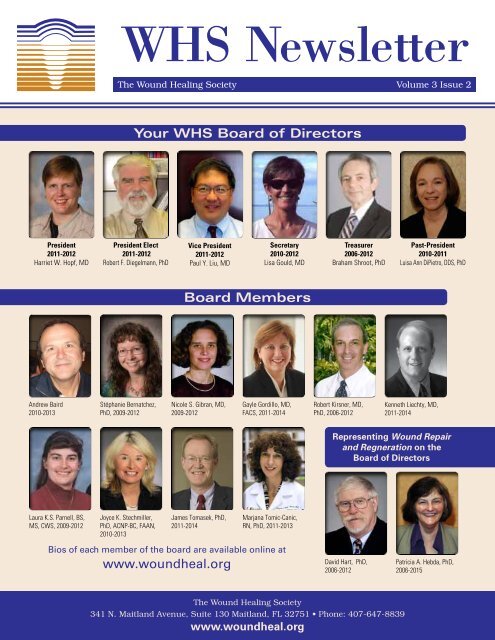

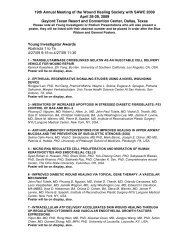

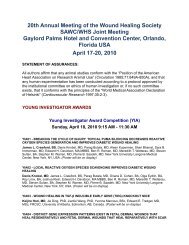
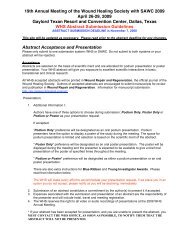
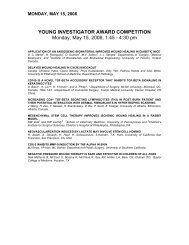

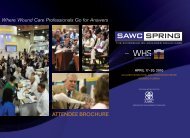

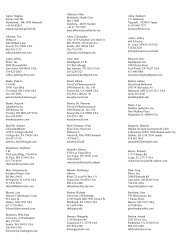
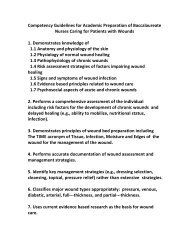
![2010 Abstracts-pah[2] - Wound Healing Society](https://img.yumpu.com/3748463/1/190x245/2010-abstracts-pah2-wound-healing-society.jpg?quality=85)